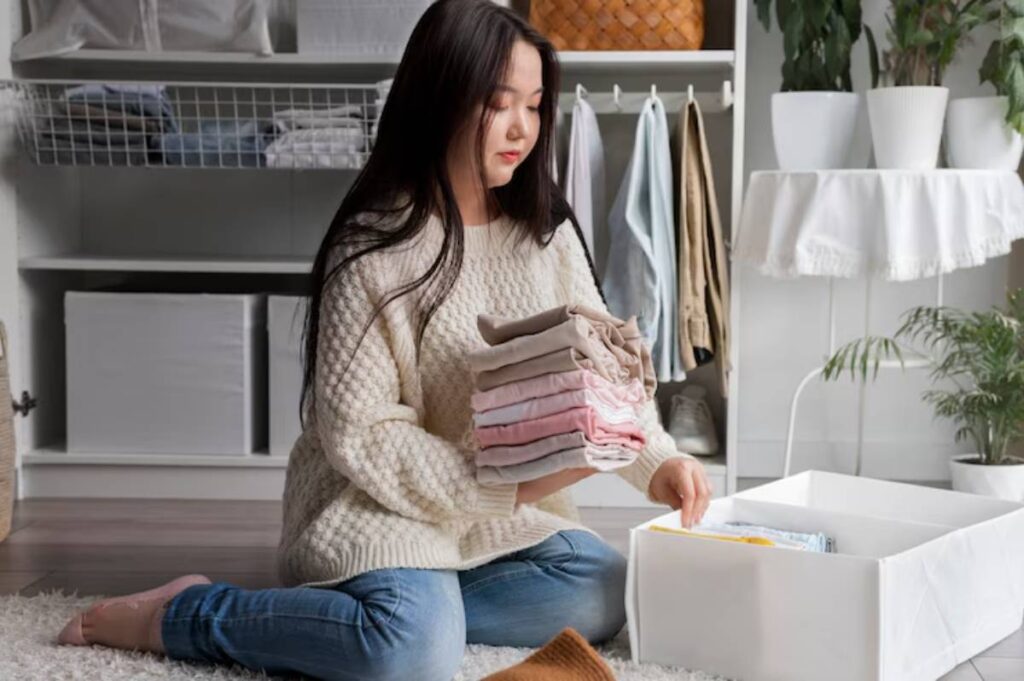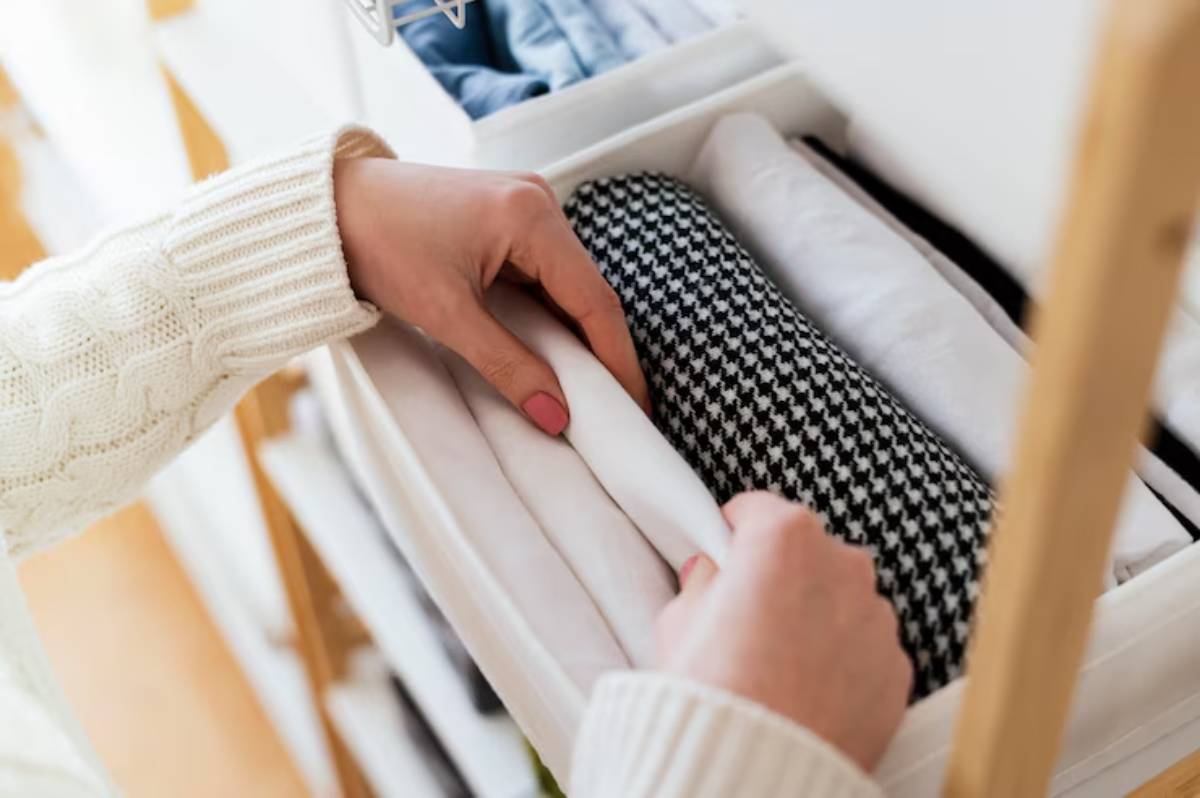The Interior Design Blog

How to Store Off-Season Clothes in a Tiny Closet
When you live in a small flat or share a wardrobe with a partner, every hanger becomes precious real estate. Storing off-season clothes in a tiny closet isn’t just about squeezing in one more jumper — it’s about reclaiming space, clarity, and sanity.
If your winter coats are suffocating your summer dresses or your jumpers are toppling off shelves during July, it’s time to rethink how you handle seasonal clothing. This guide offers compact clothing storage strategies that work for the tiniest closets and tightest wardrobes — no spare room needed.
Understanding the Core: Why Seasonal Clothing Storage Matters

In small spaces, storing everything at once simply isn’t functional. Seasonal rotation isn’t about hoarding; it’s about intentional living. By only keeping the current season’s wardrobe accessible, you reduce clutter, visual overwhelm, and decision fatigue.
But compact storage is more than folding things smaller — it’s about:
- Using vertical and underutilised space
- Selecting the right containers and storage tools
- Keeping items clean, protected, and easy to rotate
Experts in home organisation agree that rotating clothes seasonally can extend the life of garments, reduce laundry chaos, and even refresh your personal style. And you don’t need a walk-in wardrobe to make it work.
Quick Guide: Off-Season Clothes Storage in a Tiny Closet
- Declutter clothes you won’t wear again.
- Sort by season and item type (e.g. coats, knits, swimwear).
- Clean and dry before storing to prevent mould and pests.
- Use vacuum bags, slim bins, and under-bed containers.
- Label each storage unit clearly.
- Store vertically or in less-used spots (e.g. top shelf, behind furniture).
- Rotate with the change of season — make it a routine.
Step-by-Step Guide: How to Store Off-Season Clothes in a Small Closet
1. Edit Ruthlessly Before You Store
Before storing anything, ask yourself:
- Did I wear this in the last season?
- Do I still love it?
- Is it damaged or worn out?
Pro Tip: Fewer clothes = faster storage = more space for the ones you love.
2. Sort by Season and Category
Separate items clearly:
- Winter: Heavy coats, scarves, knits, boots
- Summer: Lightweight dresses, shorts, sandals
- Transitional: Items like cardigans or light jackets can be used year-round — keep a small section for them
Use clear plastic bags or laundry baskets to stage your categories during sorting.
3. Wash, Dry & Prepare Garments for Storage

Clean clothes last longer and discourage pests like moths. Dry them completely to avoid musty smells.
- Use lavender sachets or cedar chips instead of mothballs for a natural, fresh scent
- Mend any buttons, zips, or loose hems before packing away
Important: Never store damp or dirty clothes — it invites mould and mildew.
4. Choose Smart Storage Containers
In tiny closets, thin and stackable is best.
Options include:
- Vacuum storage bags: Ideal for bulky items like coats and jumpers
- Flat under-bed bins: Great for shoes or off-season accessories
- Over-door organisers: For items like scarves, gloves, or tanks
- Modular cubes: Stack in vertical space or top shelves
Explore how others use modular cube storage for flexible design to tailor space-saving setups that grow with your needs.
5. Label Everything Clearly
This step saves time and frustration later.Use:
- Label makers
- Masking tape + marker
- Clear bins (so you see the contents)
Pro Tip: If you’re visually inclined, add colour-coded dots (e.g., blue for winter, yellow for summer).
6. Use Forgotten Spaces for Storage
- Under the bed
- Above the wardrobe (use a folding step stool to reach)
- Behind doors or in suitcases
Even an ottoman or unused suitcase can hold a season’s worth of swimwear or puffer jackets.
7. Create a Seasonal Swap Routine
Mark your calendar for:
- Spring wardrobe switch: March or April
- Autumn rotation: September or October
Treat it like a seasonal reset for your home. It’s also a great time to donate what didn’t wear.
Important: Avoid leaving plastic bags or boxes on damp floors — place on risers or shelves where airflow exists.
Best Practices & Additional Insights
Use Your Closet Like a Rotating Display
Think of your closet as a boutique — showcase only what’s relevant and tuck the rest behind the scenes. This not only streamlines daily dressing but makes you more mindful of what you actually wear.
Real-World Use Case
Tina, a student living in a 10m² studio in Manchester, stores her bulky winterwear in vacuum-sealed bags under her bed. She rotates these out every April and October, using IKEA bins that slide into the base of her daybed. Labelling each by month saves her time every term.
Embrace Vertical and Hidden Zones
Small space living means rethinking unused areas. Look above your wardrobe for bins, behind your mirror for hooks, or beneath your sofa for low-rise storage trays.
Learn how to use under-furniture space for storage to fully unlock compact home efficiency.
FAQs
- Can I store off-season clothes in the attic or basement?
Only if they’re temperature- and moisture-controlled. Otherwise, clothes can become mouldy or attract pests. - How do I prevent musty smells in stored clothing?
Make sure items are completely dry, and add natural scent boosters like lavender sachets or baking soda pouches. - Is vacuum sealing safe for all clothing?
Yes for most, but avoid for delicate items like silk or leather as compression can damage their structure. - How often should I rotate my wardrobe?
Twice a year is standard — once in spring and once in autumn. - What’s the best way to store off-season shoes?
Use breathable bags or boxes. Add silica gel packs to absorb moisture and keep shape with rolled-up socks or shoe forms.
The Smarter Way to Store Seasonally
By learning how to store off-season clothes in a tiny closet, you’re not just saving space — you’re making daily life easier. A well-rotated wardrobe means fewer forgotten favourites, less visual clutter, and more clarity about what you own.
Seasonal closet hacks aren’t about having less — they’re about accessing what you need when you need it.
Feeling inspired to take control of your wardrobe? Start your seasonal swap today and reclaim your closet, one clever container at a time.









